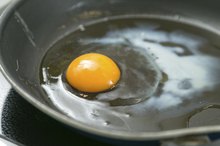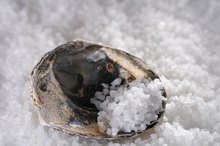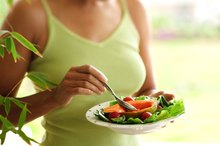Are There Foods That Cause the Release of Norepinephrine and Dopamine?
What you eat affects your mental state. Not only do food choices have an impact on your weight and heart health, but they also contribute to feelings of depression or stress. Compounds in certain foods stimulate your brain to produce dopamine, a neurotransmitter that affects your get-up-and-go. Dopamine is converted into norepinephrine, a neurotransmitter released in response to stress. Norepinephrine makes your heart beat faster. In turn, your blood pumps harder, and your mental acuity surges. Raising your body's ability to produce these neurotransmitters naturally may help you break away from feelings of apathy and hopelessness. Your diet is one of the easiest places to start this process.
Nutrients and Neurotransmitters
Neurotransmitters act as messenger molecules in the brain and nervous system and affect just about every cell in the body. Low levels of dopamine and norepinephrine lead to lack of motivation, fatigue, addictive behavior, irritability and memory loss. Cravings for junk food, anger and thyroid dysfunction can also manifest from low dopamine levels.
The amino acids tyrosine and phenylalanine are converted into dopamine. For this to happen, cofactors from vitamin C, vitamin B-6 and folic acid as well as the minerals zinc, copper, magnesium, iron and manganese must be present.
For the dopamine to be used optimally by your body, the B vitamins are also essential. In addition, vitamin C supports the conversion of dopamine to norepinephrine.
High-Protein Foods
Neurotransmitter Foods for the Brain
Learn More
Tyrosine and phenylalanine are both highly concentrated in high-protein foods, including meat, cottage cheese and wheat germ. Chicken, turkey, yogurt, tuna, eggs and seafood are other sources. Vegetarian choices include tofu, beans, peas, lentils and soy products.
Dark chocolate isn't a high-protein food, but it also enhances tyrosine and phenylalanine.
Vitamin-Rich Foods
Dairy and meat offer ample amounts of the B vitamins, too. Foods with high amounts of folate, or folic acid, include most fruits and vegetables, whole grains, beans, fortified cereals and grains. B-6 is most prevalent in cereals and grains, as well as beans, poultry, fish, dark leafy greens and orange fruit -- such as papayas, oranges and cantaloupe. Vitamin C is also found in these and other colorful fruits, as well as in vegetables such as red peppers, broccoli and red cabbage.
Mineral Focus
The Tyrosine in Bananas
Learn More
Many of the foods with amino acids and B vitamins that support dopamine and norepinephrine production also provide ample servings of magnesium, including nuts, pumpkin seeds, soy and lima beans and oatmeal. Iron is found in red meat, seafood and dark green leafy foods, while most fortified grains meet your need for zinc. Get manganese when you eat whole grains, nuts and leafy vegetables. Your body obtains the mineral copper from organ meats and shellfish, nuts, seeds and fortified whole grains.
Related Articles
References
- Journal of Clinical Psychiatry: Relationship of Neurotransmitters to the Symptoms of Major Depressive Disorder
- Dr. Mark Hyman: UltraWellness Lesson 3: Hormones & Neurotransmitters
- JAMA Psychiatry: Reduced Brain Norepinephrine and Dopamine Release in Treatment-Refractory Depressive Illness
- Natural Choices for Attention Deficit Disorder: For Adults and Children Who Want to Achieve Mental Clarity; Jane Oelke
- Advancing Medicine With Food and Nutrients, Second Edition; Ingrid Kohlstadt
- Age Right: Turn Back the Clock With a Proven, Personalized, Anti-Aging Program; Karlis Ullis
- Harvard School of Public Health: Three of the B Vitamins: Folate, Vitamin B6, and Vitamin B12
- Linus Pauling Institute: Micronutrient Information Center
Writer Bio
Andrea Cespedes is a professionally trained chef who has focused studies in nutrition. With more than 20 years of experience in the fitness industry, she coaches cycling and running and teaches Pilates and yoga. She is an American Council on Exercise-certified personal trainer, RYT-200 and has degrees from Princeton and Columbia University.








